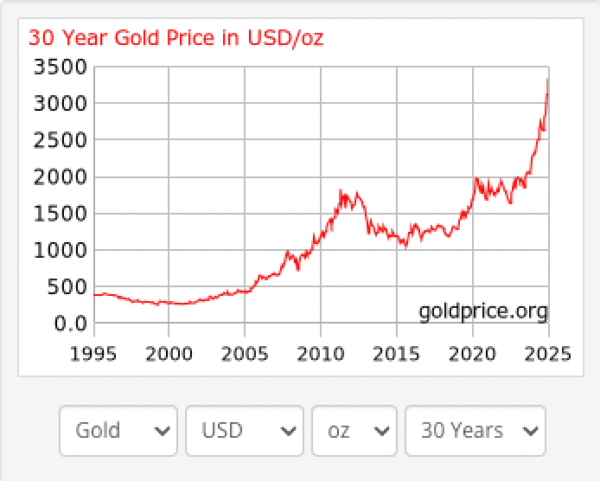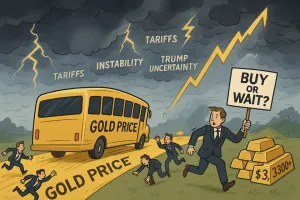What’s the opposite of trying to catch a falling knife? The phrase is often used when investors see the price of an equity falling, think it has to now be a bargain, only to experience the joy of it falling further.
The opposite, I suppose, is chasing a rally; if you see an asset rising fast, when do you jump in? The experience can be the same, but the description is not as graphic.
If you are trying to be cynical, you could say, well, I didn’t chase the rally; I enthusiastically overpaid because I like the feeling of temporary euphoria followed by longer-term disappointment. Often, what happens if you try to chase a rally, is that you end up being slapped with a restraining order.
But with gold now, the choice is really tough because, on the one hand, the chances that the seas will get less rough seem very distant. On the other hand, gold’s price rise has been so dramatic, it’s hard to avoid the feeling that much of the race has been run.

The sheer dimensions of the rush into gold are so weird. The gold price is not just dramatically up; it’s double its previous record high. It’s not that gold hasn’t risen faster or by as much in history. Gold is up about 29% over the past four months, which is about 6.25% per month. That’s not as fast as 1979/80, when it rose 276% in 12 months, which is about 30% per month.
The difference is that this time, the nominal price is a record, around $3,330 (R62,034) today, and the previous rallies in 1973 and 1979 were caused by huge surges in inflation. This time, the rally’s speed is taking place in the context of much less extreme economic conditions. Interest rates have been more or less static for the past year, which means the rise is not being driven by rising interest rates, which typically suppress the gold price.
Gold has risen faster and more in the past, particularly during 1979-1980 (276% in 12 months, 30% monthly) and 1973-1974 (200% in 24 months, 8.3% monthly) rallies, driven by extreme inflation and systemic shifts. The 2025 rally (25% in four months, 6.25% monthly) is rapid, but not the fastest and, while its magnitude is significant, it’s dwarfed by earlier surges in percentage terms.
However, the nominal price ($3,300+) is a record and, inflation-adjusted, it may have edged out the 1980s peak, a milestone not seen in 45 years. The current rally’s speed and level are notable, given less extreme economic conditions, reflecting unique drivers like central bank diversification and geopolitical risks.
Obviously, that means investors are not looking for an inflation hedge, but are responding to what are politely described as “geopolitical risks”. That’s econ-speak for the possibility that US President Donald Trump will do something else entirely bonkers.
But even that is not a complete description, because the equity markets have typically bounced back, as they did yesterday, when Trump retracted his last bout of being a stable genius. Trump now claims that he has no plans to fire Federal Reserve chair Jerome Powell and that tariffs on Chinese goods would “come down substantially”. That perked up the equity markets, and gold did lose some of its value.
But if you just compare the rise in the gold price with the decline in stock prices, it’s obvious gold is rising much, much faster than stock prices are falling. Ergo, there is more going on here than just political gyrations.
There are other indicators too. The most obvious is that global central bank gold purchases are now becoming really substantial: they exceeded 1 000 tonnes in 2024, breaking the all-time record set just one year earlier. China, Türkiye and India led the charge.
Gold-backed exchange-traded funds (ETFs) saw record inflows of $10-billion (R186-billion) in Q3 2024 and $21.1 billion (R393-billion) in Q1 2025, which to me suggests a much longer-term change in mentality. Essentially, investors around the world are now thinking they should have a little bit of gold in their portfolios just as a mitigator against volatility and much deeper geopolitical tensions than relatively trivial issues like the ongoing Trump circus.
The third interesting thing is that investment in gold companies has now caught up with the gold price. Over the years, the gold price and the value of gold companies have tracked each other (sort of), as you might expect. But increases in the gold price often provide industrial leverage for gold companies opening up their margins. So you would expect the value of gold companies to run ahead of the price of the metal in the good times.
That wasn’t happening until recently, but now it’s happening meaningfully. That means investors expect the gold price to stay higher for longer. The big winners, by the way, have been Gold Fields and AngloGold, the two ex-South African companies that have for years been the cheapest and therefore the most natural buying targets.

I guess what I’m building up to is that potential gold investors might have missed the big rise, but the bus is not too far down the road. If you run fast enough, you might still catch it.
Or, because nothing is certain in life, you might enjoy the feeling of temporary euphoria followed by longer-term disappointment. DM
This post first appeared in the Daily Maverick. To signup for Daily Maverick's other fabulous newsletters, click below.
Please do forward this post to anyone who might be interested, and by all means ask them to include their email below to become a 💥 free 💥 subscriber. Till next time.



Join the conversation